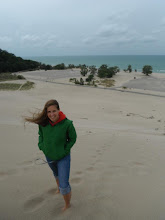- Most countries along the equator have a tropical climate, but the Andes, Amazon jungle, and cold Humboldt current moderating the desert climate of Lima and much of the coast makes for incredibly diverse climates and environments.
- 65% of the population of Peru lives in urban places, which requires more energy, has a more consumption-focused culture, becoming a "cancer for nature". Ack. Who said that? Why did I write that? That is really, really depressing. But if you think about how cities and suburbs sprawl out...
- Economy grows by selling natural resources.
- This brings me to the big reflection question for my week in Haiti, which I can't wait to tell you about: What is the value of soil?
- There are, in fact, laws about consulting with indigenous communities before granting extractive rights to international companies, but these are rarely, if ever, enforced.
- Environmental standards are lowered in the name of commerce, to ensure that impact studies don't impede business.
- Two words: eminent domain. Ok, eight words. A government that often uses eminent domain irresponsibly.
- Peru has over 70% of tropical glaciers in the world; these melt into mountaintop lagoons that run down as a very important water source for most Peruvians.
- After Cairo, Egypt, Lima is the second biggest desert city.
So in the context of a place like rural Peru, or even in busy, bustling Lima, consider that people can't just turn up the A/C or the heat, and can't just go out and buy water if anything happens to the source. Same goes for many people and places in Haiti, both rural and urban. Many of these places still rely heavily on local food sources, too, which are also affected by changing climate and environmental problems.
And while we may not feel the effects of climate change and environmental injustice as strongly in the United States, it's here. New Jersey can be broken into 5 climate zones, moderated by the wee little mountains and the great big ocean, among other factors*. To me, Virginia is just a bigger, slightly warmer version of that environment. It also has 5 climate zones, which don't exactly parallel New Jersey's, but there are some similar environmental modifiers. Peru, just a little smaller than Alaska, has 28 climate zones. (You could fit almost 76 New Jerseys in the area of Alaska. Alaska has 4 climate zones.) Long story short, Peru has a lot of different things going on with its climate, which means if some of it is changing, then it's going to snowball and affect a lot of different systems all so close together. I do not mean to be ironic talking about snow when Huaytapallana glacier has lost over half of its mass in my lifetime.
All of these systems are connected. All of these systems affect each other. Air affects soil affects water and so on and on and on. We are all connected. Or, as this mural I found in Itta Bena, Mississippi reads, we're from the same soil.

Which brings me back to that same question... what is the value of soil?
*Northwest, northeast corridor, southwest, Pine Barrens, and coast. I hope somewhere, Dave the State Climatologist is very proud of me.

No comments:
Post a Comment